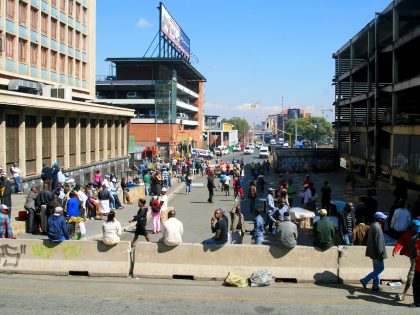What needs to fall to what needs to rise
The video playlist from our one-day symposium marking the 10th anniversary of the Marikana massacre—funded by Rosa Luxemburg Stiftung—is now on YouTube.

Image courtesy Africa Is a Country CC BY 4.0 2022.
August 2022, a decade since the Marikana massacre in South Africa when 34 striking miners were murdered by police, demanded reflection. As a result, we planned a symposium, “Marikana, 10 years on,” to discuss topics relevant to understanding, with hindsight, what happened in 2012, and to assess the events that have occurred in its wake. We tried to get perspectives from the new generation of leftists and from the so-called “born free” generation.
The speakers and panelists included Camalita Naicker (a lecturer in history at the University of Cape Town with a research focus on the “afterlives” of Marikana);, Shaeera Kalla (a prominent ex-leader of the Fees Must Fall movement, now a researcher and filmmaker); Naadira Munshi (a researcher, and activist who worked extensively with workers during the Farlam Commission and afterward); and Ziyanda Stuurman ( a researcher at the Institute for Security Studies and scholar of South African policing).
We also published a series of essays on Africa Is a Country.
The guest editors of the series of essays and organizers of the symposium were Claire-Anne Lester, Benjamin Fogel, William Shoki, and Sean Jacobs, all South Africans and, with the exception of Sean, based in the country.
The event was held at Constitution Hill, Johannesburg, South Africa on August 20th, 2022. It was also streamed online. The one-day symposium was funded with a grant from Rosa Luxemburg Stiftung’s Southern Africa Regional Office. We also partnered with the Centre for Sociological Research and Practice, as well as the Centre for Social Change at the University of Johannesburg.
You can now watch the series of four videos here:
Marikana still resonates and South Africa’s current president, Cyril Ramaphosa, was a shareholder and director at Lonmin mine at the time. It emerged that Ramaphosa used his influence as a leader of the ruling African National Congress (ANC) and as then deputy president of the country, to direct the police action against the striking mine workers.
The massacre remains a staunch demonstration that state violence of this ilk is not something that can be relegated to the colonial and apartheid past. It raised myriad questions related to post-apartheid social dynamics, most notably the question of justice for those who were killed and their families, post-apartheid labor law, the relationship between the state and capital, the working conditions for mine workers in South Africa and super-exploitation. But it also challenged the view of South Africa’s political scene as exceptional. As Sean Jacobs, founder-editor of Africa Is a Country, argued at the time: Marikana proved that South Africa’s problems were no longer specific to apartheid’s legacy, but global problems of poverty and inequality.
Various public engagements with Marikana ensued, most notably an official Commission of Inquiry, chaired by a retired judge, Ian Farlam. There is an ongoing trial for the murder of five people who died at Marikana on August 13, 2012—two mine workers and two police officers—and the trial of the provincial deputy police commissioner and other police officers. While the Farlan Commission dismissed the charge of “toxic collusion” between Ramaphosa and Lonmin, the saga still brought into sharp focus the insidious relationship between the state and capital, which privileges the powerful at the expense of the poor and working class.
The event also had immense social, political, and economic repercussions. Wages for mine workers in the platinum industry nearly doubled in its wake and we saw a revitalization of the trade union movement. Workers split from the National Union of Mineworkers (where Ramaphosa, in another life, cut his teeth as a union official) and entered new negotiating strategies with employers and formed new, independent unions. We also saw civil society groups acting in solidarity with the Marikana workers. Director Rehad Desai’s film, Miners Shot Down, which exposed the pointed plan to hunt down the striking mineworkers, was used as an organizing tool to counteract the official state narrative that the mine workers were to blame for the killing of their peers.
But the Marikana massacre also caused a permanent shift in the political spectrum. Aside from the massive strike wave across the Platinum Belt, it also spurred the official birth of the Economic Freedom Fighters, launched on October 13, 2013, in Marikana. A new political entity, flagging itself as the true workers’ party, the EFF has grown to be the third-largest party in South Africa’s parliament. The Marikana strikes also influenced other workers’ movements, like the farm worker strikes in De Doorns in the Western Cape, which galvanized more than 9,000 participants.
Marikana continues to serve as a reference for South African politics and debates from the state of the labor movement, to policing, to left political alternatives. Our symposium was indeed a timely event. But, as recognized by Kalla, the conjuncture demands a politics that goes beyond a rejection of the status quo, for a shift from “what needs to fall to what needs to rise.”



